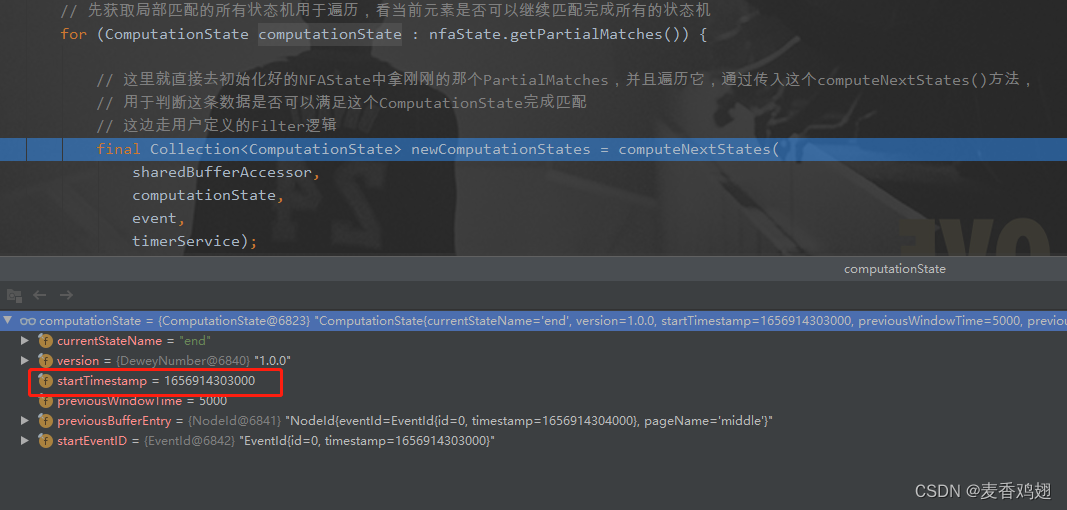上一篇文章 《Flink Cep 源码分析》我们可以知道Flink cep中Pattern的创建,state的转换,以及匹配结果的数据。这一篇则对Flink cep的两个痛点进行扩展:
1.不能动态规则更新
2.不支持 Pattern间within()
对于这两个问题的解决思路:
动态规则更新:包括 mysql存储规则信息,zookeeper通知规则更新,JaninoCompiler执行动态规则(替换groovy+aviator)
Pattern间within():则是对cep中两个Pattern间设置超时时间 新增WithinType枚举类(PREVIOUS_AND_CURRENT,FIRST_AND_LAST) 来区分是全局超时还是间隔超时设置,参考:
FLIP-228: Support Within between events in CEP Pattern - Apache Flink - Apache Software Foundation
首先,动态规则更新这个实现已经有很多大佬都出了文章,我这边也是借鉴他们的思路进行实现,并且也根据自己的想法进行了实现。大家可以看下啤酒鸭大佬的文章:
Flink cep动态模板+cep规则动态修改实践_黄瓜炖啤酒鸭的博客-CSDN博客_flinkcep动态规则
如果想要了解我的实现方式可以留言,我再写一篇文章来详细介绍下,本文先讲解下Pattern间Within()的实现方式。
1.案例代码
import org.apache.flink.api.common.eventtime.WatermarkStrategy;
import org.apache.flink.api.java.tuple.Tuple3;
import org.apache.flink.cep.condition.Begincondition;
import org.apache.flink.cep.condition.Endcondition;
import org.apache.flink.cep.condition.Middlecondition;
import org.apache.flink.cep.cus.WithinType;
import org.apache.flink.cep.pattern.Pattern;
import org.apache.flink.streaming.api.TimeCharacteristic;
import org.apache.flink.streaming.api.datastream.KeyedStream;
import org.apache.flink.streaming.api.datastream.SingleOutputStreamOperator;
import org.apache.flink.streaming.api.environment.StreamExecutionEnvironment;
import org.apache.flink.streaming.api.windowing.time.Time;
import org.apache.flink.util.OutputTag;
import java.time.Duration;
import java.util.Map;
public class FlinkCepTest {
public static void main(String[] args) throws Exception {
StreamExecutionEnvironment env = StreamExecutionEnvironment.getExecutionEnvironment();
env.setStreamTimeCharacteristic(TimeCharacteristic.EventTime);
env.setParallelism(1);
//数据源
KeyedStream<Tuple3<String, Long, String>, String> source = env.fromElements(
new Tuple3<String, Long, String>("1001", 1656914303000L, "success")
, new Tuple3<String, Long, String>("1001", 1656914304000L, "fail")
, new Tuple3<String, Long, String>("1001", 1656914305000L, "fail")
, new Tuple3<String, Long, String>("1001", 1656914306000L, "success")
, new Tuple3<String, Long, String>("1001", 1656914307000L, "end")
, new Tuple3<String, Long, String>("1001", 1656914308000L, "success")
, new Tuple3<String, Long, String>("1001", 1656914309000L, "fail")
, new Tuple3<String, Long, String>("1001", 1656914310000L, "success")
, new Tuple3<String, Long, String>("1001", 1656914311000L, "fail")
, new Tuple3<String, Long, String>("1001", 1656914312000L, "fail")
, new Tuple3<String, Long, String>("1001", 1656914313000L, "success")
, new Tuple3<String, Long, String>("1001", 1656914316000L, "end")
).assignTimestampsAndWatermarks(WatermarkStrategy
.<Tuple3<String, Long, String>>forBoundedOutOfOrderness(Duration.ofSeconds(1))
.withTimestampAssigner((event, timestamp) ->{
return event.f1;
}))
.keyBy(e -> e.f0);
Pattern<Tuple3<String, Long, String>,?> pattern = Pattern
.<Tuple3<String, Long, String>>begin("begin")
.where(new Begincondition())
.followedByAny("middle")
.where(new Middlecondition())
.within(WithinType.PREVIOUS_AND_CURRENT, Time.seconds(5))
.followedBy("end")
.where(new Endcondition())
.within(WithinType.PREVIOUS_AND_CURRENT, Time.seconds(5))
;
//TODO 内部构建 PatternStreamBuilder 并返回 PatternStream
PatternStream patternStream = CEP.pattern(source, pattern);
OutputTag<Map> outputTag =
new OutputTag<Map>("exec-timeout") {};
SingleOutputStreamOperator select = patternStream.select(outputTag, new PatternTimeoutFunction() {
@Override
public Map timeout(Map map, long timeoutTimestamp) throws Exception {
return map;
}
}, new PatternSelectFunction<Tuple3<String, Long, String>, Map>() {
@Override
public Map select(Map map) throws Exception {
return map;
}
});
select.print("normal");
select.getSideOutput(outputTag).print("timeout");
env.execute("cep");
}
}2.功能实现
2.1 首先我们创建一个枚举类,用来判断当前within是全局超时时间还是间隔超时时间
public enum WithinType {
// Interval corresponds to the maximum time gap between the previous and current event.
PREVIOUS_AND_CURRENT,
// Interval corresponds to the maximum time gap between the first and last event.
FIRST_AND_LAST;
}2.2 之后在 org.apache.flink.cep.nfa.State 类中添加一个字段来表示间隔超时时间长度
public class State<T> implements Serializable {
private static final long serialVersionUID = 6658700025989097781L;
private final String name;
private final Long previousWindowTime;
private StateType stateType;
private final Collection<StateTransition<T>> stateTransitions;
public State(final String name,final Long previousWindowTime, final StateType stateType) {
this.name = name;
this.previousWindowTime = previousWindowTime;
this.stateType = stateType;
stateTransitions = new ArrayList<>();
}
.
.
.
}2.3 上一篇文章我们讲过 org.apache.flink.cep.nfa.compiler.NFACompiler.NFAFactoryCompiler#compileFactory() 会根据Pattern创建对应的states 所以我们需要在创建state时将 previousWindowTime 设置进去,修改创建方法:
private State<T> createState(String name, Long previousWindowTime, State.StateType stateType) {
String stateName = stateNameHandler.getUniqueInternalName(name);
State<T> state = new State<>(stateName, previousWindowTime, stateType);
states.add(state);
return state;
}2.4 org.apache.flink.cep.nfa.NFA#computeNextStates() 方法中会根据当前的state计算出下一个state是什么。之后调用org.apache.flink.cep.nfa.NFA#addComputationState()创建新的computationState。
private void addComputationState(
SharedBufferAccessor<T> sharedBufferAccessor,
List<ComputationState> computationStates,
State<T> currentState,
NodeId previousEntry,
DeweyNumber version,
long startTimestamp,
EventId startEventId) throws Exception {
ComputationState computationState = ComputationState.createState(
currentState.getName(), previousEntry, version, startTimestamp, currentState.getPreviousWindowTime(), startEventId);
computationStates.add(computationState);
sharedBufferAccessor.lockNode(previousEntry);
}2.5 当对数据进行处理是遍可以看到计算中的状态 computationState 包含 previousWindowTime 这个字段。

2.6 org.apache.flink.cep.nfa.NFA#advanceTime() 超时处理地方进行间隔超时判断和全局超时判断。 isStatePreTimedOut() ,isStateTimedOut()
public Collection<Tuple2<Map<String, List<T>>, Long>> advanceTime(
final SharedBufferAccessor<T> sharedBufferAccessor,
final NFAState nfaState,
final long timestamp) throws Exception {
final Collection<Tuple2<Map<String, List<T>>, Long>> timeoutResult = new ArrayList<>();
final PriorityQueue<ComputationState> newPartialMatches = new PriorityQueue<>(NFAState.COMPUTATION_STATE_COMPARATOR);
for (ComputationState computationState : nfaState.getPartialMatches()) {
if (isStateTimedOut(computationState, timestamp)) {
if (handleTimeout) {
// extract the timed out event pattern
Map<String, List<T>> timedOutPattern = sharedBufferAccessor.materializeMatch(extractCurrentMatches(
sharedBufferAccessor,
computationState));
timeoutResult.add(Tuple2.of(timedOutPattern, computationState.getStartTimestamp() + windowTime));
}
sharedBufferAccessor.releaseNode(computationState.getPreviousBufferEntry());
nfaState.setStateChanged();
} else if (isStatePreTimedOut(computationState, timestamp)) {
if (handleTimeout) {
// extract the timed out event pattern
Map<String, List<T>> timedOutPattern = sharedBufferAccessor.materializeMatch(extractCurrentMatches(
sharedBufferAccessor,
computationState));
long previousTimestamp = computationState.getPreviousBufferEntry().getEventId().getTimestamp();
timeoutResult.add(Tuple2.of(timedOutPattern, previousTimestamp + computationState.getPreviousWindowTime()));
}
sharedBufferAccessor.releaseNode(computationState.getPreviousBufferEntry());
nfaState.setStateChanged();
} else {
newPartialMatches.add(computationState);
}
}
nfaState.setNewPartialMatches(newPartialMatches);
sharedBufferAccessor.advanceTime(timestamp);
return timeoutResult;
}2.7 查看超时数据
























 2546
2546











 被折叠的 条评论
为什么被折叠?
被折叠的 条评论
为什么被折叠?










